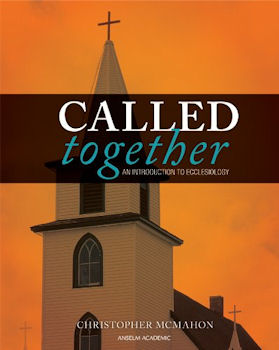
|
Posted March 22, 2012
Book: Called Together: An Introduction to Ecclesiology Author: Christopher McMahon Anselm Academic, Winona, Minn. 2012. pp. 182 An Excerpt from the Jacket:
An Excerpt from the Book: The Danger of Common Sense Lonergan described the distortions of conscious intentionality in terms of bias. The biases revolved around preoccupations with the individual and the groups to which individuals belong. In these instances, one's knowing and valuing center on what might benefit the individual or the group to which the individual belongs. These distortions are often relatively easily identified, though they are often difficult to remedy. More insidious, however, is what Lonergan calls "the general bias of common sense." For Lonergan, common sense refers to knowledge that is "gained through the senses and is limited to the senses," and for the most part, this knowledge is a good thing. Common sense keeps humans safe when crossing the street, it helps them understand how to grow crops, nurse an injury, and do all sorts of practical things that are the bedrock of day-to-day survival. The problem with common sense is that it has the tendency to assert its hegemony over the entire range of human cognition so that what is true and what is good become reduced to what is practical, tangible, and profitable. In brief, this is an inversion of many popular theological approaches to Satan and sinfulness. Many understand Satan as a prideful rebel rejecting divine authority by seeking to place himself above God. However, for Longergan, sin is rather an abandonment of transcendence in favor of something less; it is an "underreaching" in one's valuing. It is often compared to an addiction, the "infinite desire for a finite object." Such an addiction is devastating for individuals and those around them, but what happens when the addiction is written into the social and cultural dimensions of human life? The social dimensions of sin are manifested within the systems humans construct to promote living together. Put quite simply, humans live in community, in part to promote a common welfare. When various forms of bias skew a person's thinking or valuing, however, that thinking or valuing is expressed and entrenched within social systems. The ordering of society reflects this. Consider for example the social situation, broadly speaking in Central America, where the vast majority of the population is indigenous or a mixture of Spanish and indigenous ancestry (mestizo or ladino). The economic infrastructure of many of these countries, until very recently, was controlled by a small number of families, almost all of them descendents of Spanish colonizers. Land had been granted to these families by the Spanish government as a reward and as an obligation. Spanish colonizers were to work the land in order to harvest natural resources (gold and other material) or to produce goods (sugar cane, cocoa, coffee, fruit) for sale and trade. Notice the thinking of the Spanish colonizers that went into this enterprise: a. the land belongs to us because we have the power and therefore the right to take it; b. the land and its resources are to be harvested for the benefit of the Spanish and not for the indigenous people of the land; c. the indigenous people of the land are here for our benefit and can be used as we see fit. In this pattern of thinking certain values emerge, values that reflect group bias and the general bias of common sense. The question of what is truly good is distorted and replace with questions that revolve around limited goods; "what is good" means "what is good for us," and "what is good" is "What is practical and profitable." These biases reflect the thinking of only a few people; however, they have been written into the social order. Sin is evident in the history of social relationships in these countries along the lines just described. Table of Contents: The story of Jesus The work of Christ and the nature of the Church The evolution of the Church's self-understanding The Second Vatican Council The church in a culture of disbelief The church and its liturgical constitution The church and the work of redemption in the world |
|
